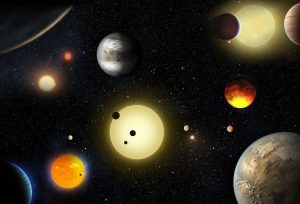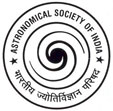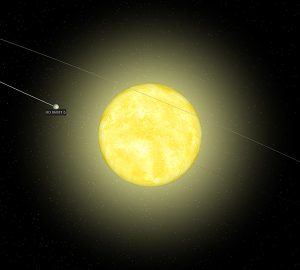Name ExoWorlds (2022)
20 Stars, 20 Worlds... waiting for you to name them!
Name an exoplanet and its parent star : an opportunity for everyone
Astronomers have discovered more than 5000 planets orbiting other stars in the last few years, and these planets need to be named! The International Astronomical Union (IAU) is mainly responsible for the naming of astronomical bodies. In their centenary year, the IAU has announced a campaign where everyone will get a chance to suggest a name for a particular exo-planet and its parent star, hence the name of the campaign - NameExoWorlds.
The NameExoworlds India, 2019 campaign was successful in assigning two Indian names in the Sky. The NameExoWorlds 2022 edition will be a bit different, but will allow the IAU to bring together the public, amateur astronomers and exoplanetary scientists and together to name a new set of available exoworlds. Anyone, including students and teachers, astronomy enthusiasts, amateur astronomers and exoplanetary scientists, may form a team and propose names for 20 exoplanetary systems, each of which consists of one known exoplanet and its host star. The systems to be named by NameExoWorlds 2022 are of special interest, as they are among the first exoplanet targets of the James Webb Space Telescope (JWST).
NameExoWorlds 2022 is a collaboration between the Executive Committee Working Group on Exoplanetary Systems Nomenclature and the IAU Office for Astronomy Outreach. The National Vetting Process will be facilitated by the National Outreach Coordinator (NOC) India, other national IAU representatives and representatives from the national astronomy community.
Salient Points of the Contest
- Any team can put in name suggestions for any of the 20 stars and their exoplanet .
- A team can be formed with some combination of students and teachers, astronomy enthusiasts, amateur or professional astronomers.
- The submission will have an explanation in text and video form, along with a report of the compulsory public outreach initiative by the team.
- Only this form can be used for all submissions.
- Entries can be submitted directly to the IAU until 11 December, 2022.
- A national vetting process for shortlisted names will be over by 15 January, 2023.
- A final set of names and two backups will then be sent as Indian nominations to the International Astronomical Union.
- All national pairs of names for all systems from all over the world will be voted upon by the discoverers, together with the IAU Executive Committee Working Group.
- The final names for each exoworld system will be announced by the IAU on 20 March, 2023 along with the winning team for each.
Steps to participate in the Contest
1.
Form a team
A team can consist of teachers and students, astronomy enthusiasts, amateur astronomers or professional astronomers. There should be some combination of the above, with members from multiple categories, if possible. There is no upper limit to the number of people a team, but a minimum of two is good to have.
2.
Organize exoplanet outreach
A team must organize at least one public outreach activity related to exoplanets (more is better).
These activities can be in the form of public awareness regarding exoplanets, the discovery and importance of exoplanets, the possibility of life beyond the Earth, etc. Public outreach activities can take the form of craft activities, public lectures, or online activities.
3.
Decide on a pair of names
It is best for a team to first study all the 20 stars and their exoplanets., for their properties etc. Having an astronomer or a person knowledgeable in astronomy will help in this.
Based on this study and / or any local reasoning, the team is free to decide the method of choice of names to be submitted in the proposal. The IAU Naming Rules need to be adhered to. The proposed pairs of names - for the exoplanet & its star - must follow a common, logical naming theme.
Teams can even use the outreach event to decide on a name pair. They can vote from participants after the public outreach activity, or vote separately beforehand and announce the name chosen as part of the outreach event.
Note: Teams have the option to propose pairs of names (and the associated theme) that can be applied to any system, but this will put your proposal at a disadvantage during the selection process.
4.
Register team and submit proposal
Submission form Shortlink : https://bit.ly/2022NameExoWorlds
All submissions are due by 11 December, 2022.
Register your team and submit a proposal of the chosen system name in the form of a written English narrative (one page A4, 10 font, double spaced, maximum 300 words) and a short 3-minute video presentation via this form .
If you can't access Google Forms for some reason or don't have Google account access, please fill out this form and send it to nameexoworlds2022@oao.iau.org by email.
The proposal cannot be changed once submitted. Thus the team should carefully read the NameExoWorlds Naming Rules . These have to be strictly adhered to so as to avoid disappointment.
In case of a serious doubt, please contact IAU NOC India -
![]()
Some rules and details of the contest
(click headings below to show some salient points. These are not a complete list.
You must also read the Detailed Rules by the IAU before submitting.)
[bg_faq_start]
Who is eligible to participate?
The competition is open to all people in the world in the form of teams composed of some combination of teachers and students, astronomy enthusiasts, amateur astronomers or professional astronomers. Each team is allowed to submit one proposal to name an exoworld (exoplanet+host star) by using this form.
What is to be kept in mind when submitting names?
- Names suggested can be in any Indian language including English.
- Name suggestions must be accompanied by a justification of 300 words, preferably in English (given the international nature of the event). Proposers are encouraged to make a presentation in their own languages (video of a maximum of 3 minutes).
- The participant teams must compulsorily organise an outreach event (possibly exoplanets related) and submit it's details as well.
- Submission will only be accepted via this form.
- Accurate contact information is necessary as the team’s identity will be confirmed if the entry is shortlisted.
- The team’s participants and details should be mentioned correctly to avoid disqualification.
What kind of names can or cannot be suggested?
The proposed pairs of names - for the exoplanet & its star may be:
- One word if possible
- Pronounceable and not offensive to anyone (in any language)
- Of things, or places of long-standing cultural, historical, or geographical significance, worthy of being assigned to a celestial object.
- Follow a logical naming theme (eg. a local river and its source). Not necessarily, but they may be drawn from themes related to the sky and astronomy.
- Not be too similar to the existing name of an astronomical object.
Names already given to astronomical objects can be checked here (for galactic and extragalactic names) or in the MPC database (for asteroid and satellite names). Details of the IAU naming process can be found here.
- Not be too similar to the existing name of an astronomical object.
In addition, do NOT suggest:
- Names of real people, living or dead
- Names that are newly "invented" by the team
- Names of things or places primarily known for political, military or religious activities
- Names of a purely or mainly commercial nature or subject to copyrights as may be the case with names created in fiction such as books, games, movies, etc.
How will the selection process work?
- The process is being overseen by the IAU's Executive Committee Working Group on Exoplanetary Systems Nomenclature and the IAU Office for Astronomy Outreach. All entries must be submitted to them by using this form.
- The primary shortlisting of name proposals for each country will be done by the IAU.
- A list will be shared with a National Vetting Committee of experts (NVC) for each country. The members for Inida are listed below.
- One best and two backup suggestion will be sent as Indian nominations to the International Astronomical Union by the NVC.
- The sole and final authority of any decision rests with the NVC and it will not be contested in any manner.
What is the planned timeline of NameExoWorlds 2022 contest?
| Opening of competition by IAU |
|
| Closing of entry submission |
|
| Shortlisted names submitted to IAU after National Vetting Process |
|
| IAU Voting and Selection of the Names ends |
|
| Public Announcement of final selections by IAU |
|
| National level outreach continues ... |
Who are part of the National Committee?
- Samir Dhurde
Convenor, IAU National Outreach Coordinator
(Inter-University Centre for Astronomy and Astrophysics, Pune) - Dibyendu Nandi
Astronomer / Chair, ASI Public Outreach and Education Committee
(Indian Institute of Science Education and Research (IISER), Kolkata) - Harvinder Kaur Jassal
Astronomer
(IISER, Mohali) - Manzoor Malik
Astronomer
(University of Kashmir, Srinagar) - Niruj Mohan Ramanujam
Astronomer
(Indian Institute of Astrophysics, Bengaluru) - Sarita Vig
Astronomer
(Indian Institute of Space Science and Technology, Thiruvananthapuram)
[bg_faq_end]
The original submissions will not go through the National Vetting Committee, nor will any member of the NVC be a part of any team submitting a name proposal. The distinguished committee will fairly consider all relevant aspects and decide based on the rules. At the end of the contest, its decision will be final. The selected names being assigned to the exoplanet system are subject to the final approval of International Astronomical Union (IAU).
NameExoWorlds 2022:
The Planetary Systems
Click this link to go to WikiSky , where you can locate these systems.
The following is the list of host stars/exoplanets involved in the 2022 edition:
- Star GJ 1214 & Exoplanet GJ 1214b [in constellation Ophiuchus]
- Star GJ 3470 & Exoplanet GJ 3470b [in constellation Cancer]
- Star GJ 367 & Exoplanet GJ 367b [in constellation Vela]
- Star GJ 436 & Exoplanet GJ 436b [in constellation Leo]
- Star GJ 486 & Exoplanet GJ 486b [in constellation Virgo]
- Star HAT-P-12 & Exoplanet HAT-P-12b [in constellation Canes Venatici]
- Star HAT-P-26 & Exoplanet HAT-P-26b [in constellation Virgo]
- Star HATS-72 & Exoplanet HATS-72b [in constellation Aquarius]
- Star HD 95086 & Exoplanet HD 95086b [in constellation Carina]
- Star HIP 65426 & Exoplanet HIP 65426b [in constellation Centaurus]
- Star LHS 3844 & Exoplanet LHS 3844b [in constellation Indus]
- Star LTT 9779 & Exoplanet LTT 9779b [in constellation Sculptor]
- Star L 168-9 & Exoplanet L 168-9b [in constellation Tucana]
- Star WASP-121 & Exoplanet WASP-121b [in constellation Puppis]
- Star WASP-166 & Exoplanet WASP-166b [in constellation Hydra]
- Star WASP-19 & Exoplanet WASP-19b [in constellation Vela]
- Star WASP-43 & Exoplanet WASP-43b [in constellation Sextans]
- Star WASP-63 & Exoplanet WASP-63b [in constellation Columba]
- Star WASP-69 & Exoplanet WASP-69b [in constellation Aquarius]
- Star WD 0806-661 & Exoplanet WD 0806-661 B [in constellation Volans]
The links above lead to the List of ExoWorlds 2022 on the official contest site.
An exoplanet discovery has won a Nobel Prize!
What is an Exoplanet?
Our solar system has eight planets and many other bodies revolving around the Sun. Such systems exist around other stars too. Astronomers call planets that orbit around other stars extrasolar planets or "exoplanets".
How do we discover Exoplanets?
 Exoplanets are very difficult to find around their parent stars. They are hidden by the bright glare of the stars they orbit. They do not have light of their own and may not reflect enough light to be detected. Towards the end of the twentieth century, observations through space and other telescopes, along with smart usage of image processing opened the way to discovery of exoplanets.
Exoplanets are very difficult to find around their parent stars. They are hidden by the bright glare of the stars they orbit. They do not have light of their own and may not reflect enough light to be detected. Towards the end of the twentieth century, observations through space and other telescopes, along with smart usage of image processing opened the way to discovery of exoplanets.
Astronomers use different methods to detect and study these distant bodies. Exoplanets are predominantly detected by the dip in the light of their star which they eclipse, or by looking at the small wobble of the host star due to the exoplanet. A few have been found by direct imaging. Future large telescopes such as the Thirty Meter Telescope etc., with advanced technologies like adaptive optics, should be able to discover many more such worlds directly.
Resources for Teachers and Science Communicators
Help from all teachers and science communicators is welcome in publicising and running the contest. Please see below to browse the resources that will be helpful for giving more information about Exoplanets and Astronomy to your students.
The IAU National Outreach Coordinator for India invites you to be a partner in this national contest. Feel free to directly contact him for any help required.


